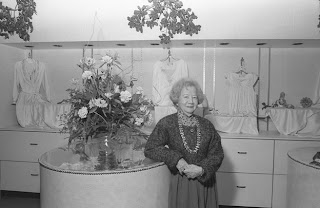Arab and Jewish Women in Kentucky
Today's guest post comes from Rosie Moosnick, author of the book Arab and Jewish Women in Kentucky: Stories of Accommodation and Audacity (University Press of Kentucky, 2012).
Kentucky isn’t the first place that comes to mind
when talking about Arabs and Jews. Not
surprisingly, when I mention my book, Arab
and Jewish Women in Kentucky: Stories of
Accommodation and Audacity, initial responses go something like there are Arabs and Jews in Kentucky? Can’t be many? No, Kentucky’s population does not resemble
New York’s or Michigan’s where Arabs and Jews abound, but Kentuckians who are
also Arab or Jewish exist even if comprising less than one percent of the 4
million of the State’s total residents.
Arab and Jewish Kentuckians’ stories are telling—the women’s, in
particular, represent the intricate identity dances that transpire away from
urban locales in this country and the Middle East.
There are contemporary women such as Sawsan Salem who
is a little over a twenty year resident of the United States, originally from
Jordan, she followed her Palestinian American husband to America. Sawsan, like so many recent immigrants, is
two places simultaneously. She is in
Kentucky but never far removed from Jordan—paying attention to both spots.
Kentucky was the third stop on her American tour
previously living in Chicago and Cleveland.
She finds Kentucky to her pleasure because the Muslim community is
religious, close-knit, and international.
Yet, she’s concerned that her children meet other Muslims and tries to
allay their concerns when they inquire, “Where am I going to meet someone?” Trips
back to Jordan offer some hope for her children’s future marital
prospects.
The Muslim community is always with Sawsan, even in
Kentucky and at her former work place in the mall, Victoria’s Secret. A steady flow of Muslim customers came to
her, women seeking advice and men instruction on what to buy for their loved
ones.
Holding onto one’s identity is one response to being
away from the Middle East or urban locations.
Distancing yourself from your ethnic/cultural peers may be another.
Sarah and Frances Myers were Jewish women who died
in the 1980s and spent their adult lives in
Hopkinsville, KY—over fifty years. They never married nor had children. Instead they ran the family business,
Arnold’s, a high end women’s clothing store.
They fancied themselves to be above and beyond Hopkinsville even though
they thrived there. They instructed
their only nephew, “Don’t bury me in Hopkinsville.” Yet, in Hopkinsville they dressed important military
dignitaries’ wives whose husbands were stationed at Fort Campbell including
General Westmoreland’s. Francis
Breathitt, the governor’s wife, turned to them for fashion help when choosing a
gown for her husband’s inauguration in 1963.
Despite success they longed for New York because
they likened themselves to be of Jackie O’s ilk, not small town Kentucky. Aspiring for urbane sophistication, they also
fashioned themselves to be unlike shetl Jews. They didn’t shun being Jewish. They travelled the hour and half to Nashville
on the High Holidays to express their devotion and they traded discounts with the
other Jewish merchants in town.
But
being Jewish did not interfere with being sophisticated. Sarah had her nose redone, toyed with
converting to the Episcopal Church, and served shrimp at their cocktail
parties. Ironically, despite her tricky
relationship with being Jewish, Sarah went to western Kentucky churches to talk
about what it meant to be Jewish.
In Kentucky, complicated stories involving both owning
and distancing oneself from one’s group of origin occurs and did occur in the
past. Simone Salomon, for instance, owns
her Jewish-ness. “It’s the first thing
that I think about myself. Is that I’m
Jewish.” Lebanese Rose Rowady,
meanwhile, during the Great Depression and amidst KKK activity in central
Kentucky brushed aside attachment to her Lebanese roots and instead aspired for
her children to simply make it financially.
What is curious is that an individual woman’s
particular identity response speaks to other women, namely, Arabs and
Jews. Who can’t be moved by the acute
observational skills Rose Rowady displayed in small town Kentucky in the 1920s
where she watched Klan parades, taking note of shoes she recognized. Connections between Arabs and Jews, despite
tensions that bedevil them even in Kentucky, emerge by way of women’s stories.



Comments